Part of a series of articles titled Alaska Park Science Volume 20 Issue 1 - Parks as Proving Grounds.
Article
Making Sound Decisions Using Bioacoustics in Alaska’s National Parks
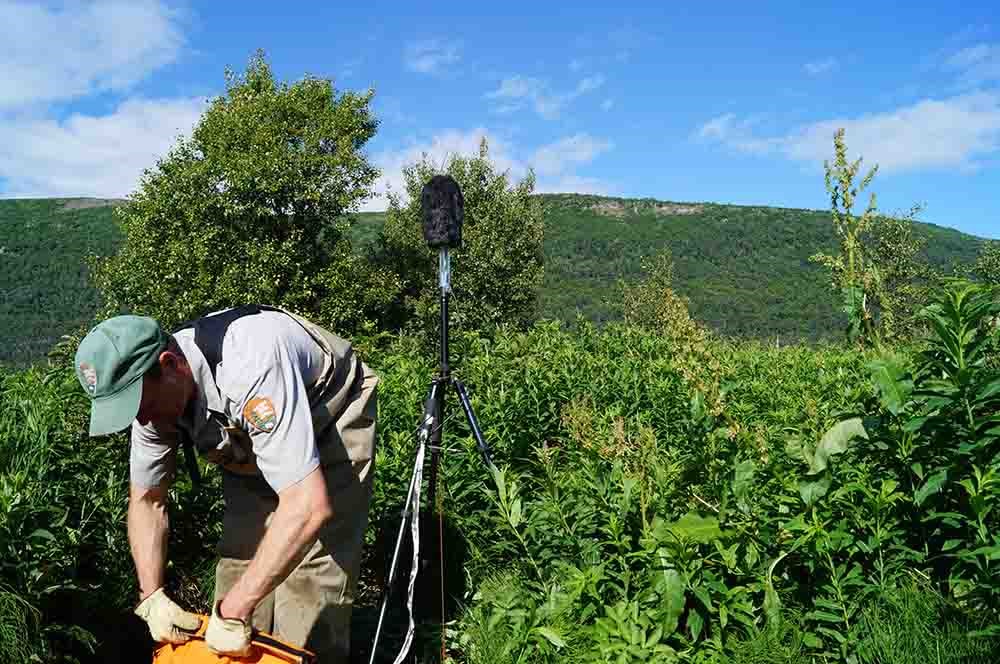
Animals are continuously immersed in acoustic signals. Physical processes of Earth’s surface—such as flowing water, earthquakes, or weather—produce sounds. Fundamental animal behaviors—such as breathing, moving, or eating—produce sounds. And of course, animals deliberately produce sounds to communicate. On top of this are the sounds that humans produce with vehicles, machinery, and other activities. Considering the continuous flow of information that acoustic environments represent, it is no surprise that every animal species has some form of ear (Horowitz 2012). The National Park Service (NPS) protects acoustic environments, meaning all the sounds occurring at a location over time plus the physical capacity of the landscape to transmit them (NPS 2006).
Western culture historically considered audible sounds to be intangible, emotional, and formless. As a result, sound was long overlooked as scientific information (Sterne 2003). The invention of audio recording devices in 1877 contributed, in part, to a paradigm shift. If sound could be documented, it could be analyzed. Since then, recording devices have become recognized as keen instruments of field science.
Acoustic recording devices allow us to extend our sense of hearing to remote places and times where we would otherwise not be listening. Instruments can document conditions on a remote mountainside continually for months at a time. They extend sensitivity beyond physiological limits, revealing sounds above (i.e., ultrasonic frequencies) or below (i.e., infrasonic frequencies) the range of human hearing. Submersible instruments can listen underwater without having to hold their breath or wear a wetsuit. The purpose of this article is to provide examples of how we use acoustics to understand wildlife and their environment (Figure 1).
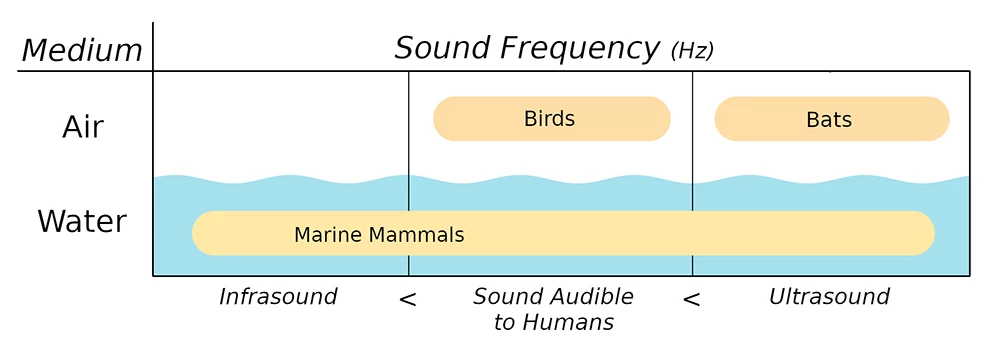
Terrestrial Sounds: From Familiar Voices, Renewed Understanding
To realize the potential of audio recording devices, the NPS is focused on analysis tools. The right tool depends on the scientific question, management issue and staff capacity. Most acoustic environments have varied, overlapping sounds. Separating, categorizing, and summarizing them is often the way to analyze sound and interpret biological significance. Many analyses proceed by a basic approach: methodical, technical listening in headphones. Listening methods are time consuming, but offer detailed results.
Purely numeric approaches are flexible enough to answer diverse questions and allow greater analysis speed. With appropriate care, numeric acoustic indices have shown great promise for biologists seeking to estimate biodiversity in time or space (for example Towsey et al. 2014, Buxton et al. 2018, Bradfer-Lawrence et al. 2019). For questions involving specific taxa, advances in technology have recently enabled identification of animal sounds at close-to-human levels. Computerized detection is currently well-defined for some taxa (for example, bats, described below) and in development for others. Software programs like Cornell Lab of Ornithology’s Raven, Wildlife Acoustics Kaleidoscope, Oregon State University’s Ishmael, or University of Costa Rica’s warbleR allow users to develop their own wildlife detectors. Fine tuning can result in a moderate-to-high level of performance.
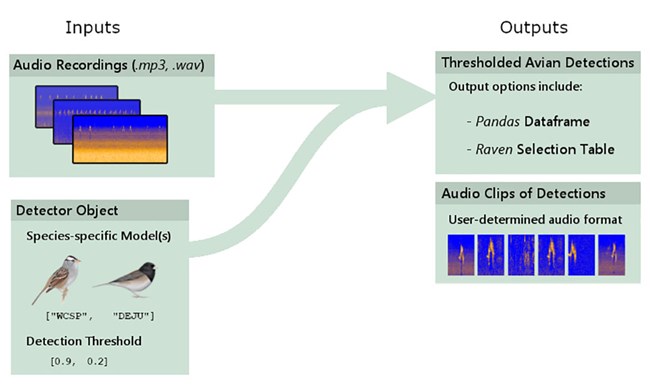
Given a large library of example sounds, machine learning is another way to develop high-quality detectors. One such machine-learning-based tool is now available to parks. Avian Acoustic Discovery: Alaska (Summers and Betchkal 2019, Figure 2) is an open-source detection tool trained using Alaskan bird dialects. The current release includes 20 different species. Many inclusions, like white-crowned sparrow (Zonotrichia leucophrys), are abundant, while others, such as orange-crowned warbler (Vermivora celata), are experiencing rapid declines in abundance (Audubon Alaska 2017). Most of the included species are migratory, but a few, like willow ptarmigan (Lagopus lagopus), are year-round residents.
Automatic detection speeds analysis of the entire audio record. Using this technique, we can track biological events across an entire season, or over several years. Records show the beginning, ending, peak, or abrupt changes in the rate of sounds. Glacier Bay National Park and Preserve has been using audio recordings to monitor the timing of bird migration since 2012 (Buxton et al. 2016). The Central Alaska Inventory & Monitoring Network’s shallow lakes monitoring program has used recorders to document the reproductive timing of wood frogs (Lithobates sylvaticus) since 2011 (Larsen 2012). Both efforts are well-suited to analysis with automated detectors.
Phenology research is one among many fields that benefit from the advancement of acoustic data tools. Consider a remarkable example: In 1974, researchers at the University of Alaska Fairbanks distinguished metapopulations of Gambel’s white-crowned sparrow (Z. leucophrys gambelii) using only acoustic properties of their song (DeWolfe et al. 1974). To do this, they required an expensive spectrograph machine that would cost over $13,000 in 2019 dollars. With Acoustic Discovery, any computer can rapidly extend the spatial extent of their work. A recording with a GPS coordinate and a white-crowned sparrow song becomes a population biology study site.
This underscores an important point: To advance the field of biology, it is critical for publicly funded recordings to be accessible for research. This involves parks working with archival institutions like the National Oceanic and Atmospheric Administration’s National Centers for Environmental Information, the Cornell Lab of Ornithology’s Macaulay Library, Xeno Canto, and others.
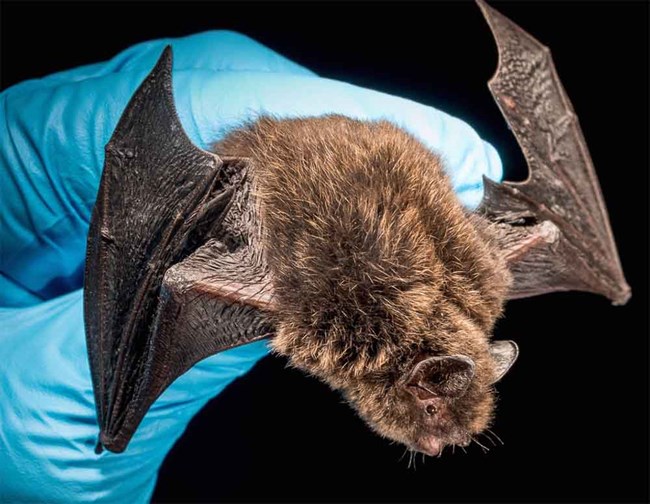
Ultrasonic Sounds: Bat Monitoring in Alaska
If you’ve never heard a bat call, there’s a good reason why: their sounds are ultrasonic (i.e., higher frequency than the range of human hearing). Several Alaska parks are monitoring the ultrasonic calls of bats to better understand their distribution, migration, and behavior.
Many people are surprised to find out that there are bats in Alaska. These elusive animals forage for insects late at night and are rarely seen other than when they end up inside people’s attics or cabins. There are six bat species in Alaska (little brown, Myotis lucifugus; silver haired, Lasionycteris noctivagans; hoary, Lasiurus cinereus; Yuma myotis, Myotis yumanensis; California myotis, Myotis californicus; and long-eared myotis, Myotis evotis), with most of the diversity in the southeast where the climate is more temperate. In southcentral and interior Alaska, the only species that has been found is the little brown bat.
Bats are small, fly quickly, and are only out for a few hours each night, so direct observation and identification is very difficult. Thankfully, bats use echolocation for navigation and hunting prey and these calls can be detected with ultrasonic microphones. Bat calls have been characterized and collected into vocal libraries for different bat species, which allows researchers to identify bats from recordings, at least to major species groups. Studying the calls also allows researchers to determine bat activity levels each night and throughout the year.
Bats in Alaska are poorly understood with regard to their habitat, prey, life cycle, and migration patterns. Though many parks have documented little brown bats in park structures and, in some cases, overwintering in structures outside the parks, very little is known about the presence of bats in natural habitats. Knowing what habitats are being used by bats helps park managers make important resource management decisions, such as leaving old-growth tree stands and snags in place because bats are using them for day roosts.
There is some acoustic and recapture data to support the idea that some bats in interior Alaska migrate to the coast in the fall, but it is not known whether all Alaska bats migrate or if some overwinter in the parks. Migration to the coast and southward would increase the opportunities for Alaska bats to interact with southern populations and carry diseases such as White Nose Syndrome northward.
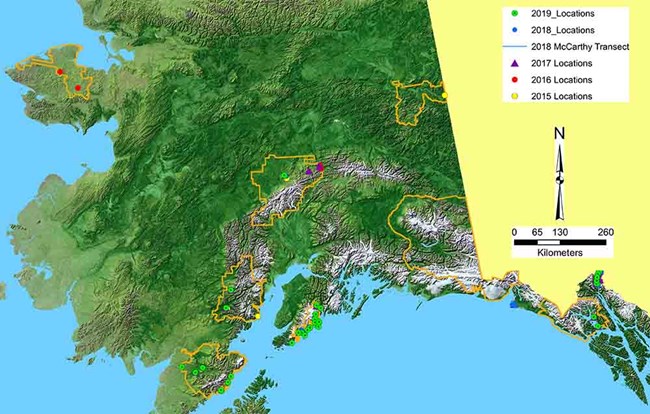
Since 2015, we have placed 82 detectors in 10 parks for over 4,500 nights of acoustic monitoring (Figure 3). The detectors were established across a wide range of habitats from coastal to forested interior and tundra. We have conducted 4 driving transects in Wrangell-St. Elias National Park and Preserve and several hiking transects from the U.S. into Canada and back along the Chilkoot Trail in Klondike Gold Rush National Historical Park.
As expected, bats are most active during the warmer months. What was unexpected is that they feed intensely for much shorter periods on a given day than predicted, frequently in the range of only two hours. This may be due to the short-to-nonexistent darkness in northern Alaska that makes it difficult to avoid predation by owls and other animals.
We have also found bats active over saltwater in Glacier Bay National Park and Preserve and Kenai Fjords National Park. It is not clear whether they are actively foraging or just using the open space to transit between feeding and roosting areas, but these were also unexpected results.
The acoustic monitoring has shown a spike in calls in the late fall in the coastal area of Klondike Gold Rush National Historical Park that roughly corresponds to when calls diminish in the interior of Alaska and Canada, suggesting that at least some bats may be migrating from those areas to the coast. We have started coordinating with the Alaska Department of Fish and Game and researchers in Canada to conduct mist netting and banding of bats to verify this, but do not have results yet.
Bioacoustic monitoring has proven to be a very effective tool to explore bat activity over a broad area with little impact on staff time. We plan to continue using acoustic monitoring long term and to use the data to guide effective mist net placement for species identification and disease screening.
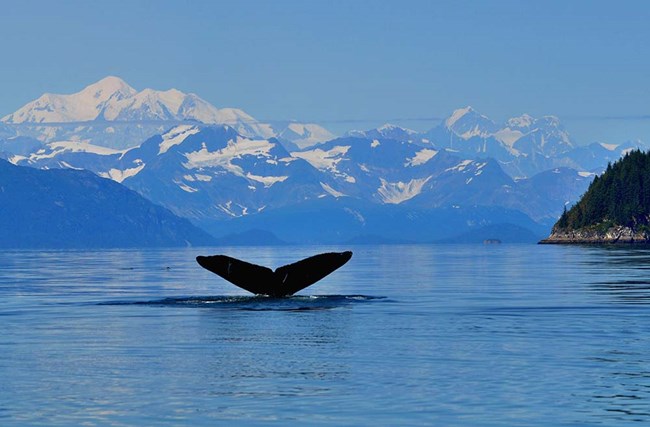
Diving Into Underwater Sound: Lessons from Glacier Bay
Aside from the occasional scuba diver, humans do not directly experience underwater sound environments in Alaska parks. However, underwater acoustic habitats are essential to the basic life functions of many aquatic animals that are ecologically important and of high interest to park visitors. Effective conservation requires that we document the underwater sound environment, how animals use it, and how management decisions affect it. Work we conduct in Glacier Bay National Park and Preserve illustrates the use of underwater acoustics to inform park management and provides a useful example of how other parks may successfully use these tools.
The story of underwater sound monitoring in Glacier Bay centers on a long-standing concern that vessel-generated noise has the potential to disturb whales and other wildlife. Knowing that animals rely on underwater listening in their daily life and that park vessel-management actions affect the underwater soundscape, our studies focus on describing natural and man-made underwater sounds and how vessel management actions, such as vessel quotas and speed limits, change the underwater soundscape.
Thinking deeply about what information is needed to answer a particular basic research or management-related question is an essential first step in bioacoustics study design and methodology. If you’re planning to make quantitative measurements, it’s important to use standard metrics that will allow you to compare your findings with those from other researchers or geographic areas.
Finding the right partners at the start is an essential ingredient to successfully using bioacoustic tools. The complexity of acoustics can be intimidating, potentially creating a formidable deterrent to using the resulting information in management decisions. The NPS Natural Resource Science and Stewardship (NRSS) Natural Sounds Program is an excellent resource for finding the right equipment and the right collaborators to collect, process, and interpret acoustic results.
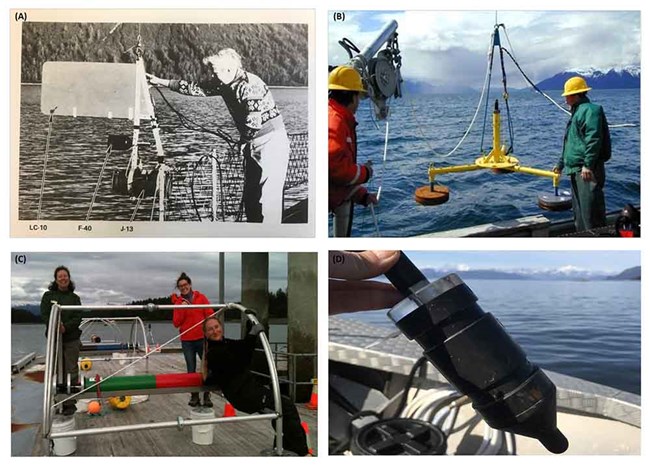
(c) In 2015-2016, graduate students from Syracuse and Oregon State Universities used an array of four anchored hydrophones to study the vocalizations of harbor seals and humpback whales. (d) In summer 2019 and 2020, we deployed a small Sound Trap.
Malme and others (1982) first quantified Glacier Bay’s underwater soundscape using portable hydrophones (underwater microphones) deployed temporarily off the side of a boat (Figure 4a). Regular monitoring of ambient underwater sound began in 2000, when park scientists in collaboration with U.S. Navy acousticians installed a calibrated hydrophone near the mouth of Glacier Bay, connected by a 5-mile (8-km) cable to a custom computer system at park headquarters (Figure 4b). With this system, we created the first comprehensive description of sound sources (wind, rain, animals, and vessel engines), how often, and what their pitch and duration characteristics were (McKenna et al. 2017). We also used this system to make calibrated measurements of specific vessels that transited past the hydrophone at a known distance determined by GPS (Kipple and Gabriele 2004). Next, using autonomous recorders from Cornell University’s Bioacoustics Research Program in 2007, we broadened our efforts to listening mid-Glacier Bay to see if the sound characteristics were different there (Figure 4c).
Most recently, in a 2015-2016 study funded by the Coastal Marine Grant Program, we worked with Oregon State University to deploy an array of hydrophones (Figure 4c) that allowed us to acoustically locate each vocalizing animal, allowing us to measure the loudness of harbor seal (Phoca vitulina) roars and humpback whale (Megaptera novaeangliae) calls (Matthews et al. 2017, Fournet et al. 2018a). This study also allowed important insights into how whale and seal vocalizations change in the presence of motorized noise (Fournet et al. 2018b). In summer 2019 and 2020, we deployed a Sound Trap® autonomous recorder to replicate the soundscape measurements made back in the 1980s in Glacier Bay and Frederick Sound to determine how the underwater sound environment has changed over time (Figure 4d).
Simple metrics and visualizations help managers understand the relative contributions of different natural and anthropogenic noise sources and how they reduce the opportunities of animals to communicate. For specialized tasks, it is often necessary to team up with collaborators who have the tools that allow us to model and visualize the results. For example, incorporating all our knowledge of Glacier Bay’s sound environment and the loudness of individual vessels into the Acoustic Integration Model (AIM), we found that cruise ship speed was the dominant factor affecting how much noise whales were exposed to in Glacier Bay, and that noise exposure is lower when ships are scheduled to synchronize their arrival times (Frankel and Gabriele 2017). We recently completed work that allowed the first assessment of the extent to which vessel-generated noise decreases the distance over which humpback whales and harbor seals can communicate, relative to how far they can communicate under naturally quiet conditions (Gabriele et al. 2018). In quiet conditions, two whales can hear each other and vocalize back and forth at a distance of about a mile and a half (2.3 kilometers). But with the noise from vessels on a typical day in the tourist season, that communication distance shrinks to about 75 yards (70 meters) or even less.
A study done in collaboration with Oregon State University under an Alaska Coastal Marine Grant showed that whales vocalized more loudly when natural or man-made background noise got louder and were less likely to vocalize when there was vessel noise than when only natural sounds were present (Fournet et al. 2018b).
Working with Cornell University’s Center for Conservation Bioacoustics, we created a visualization of a day in the life of Glacier Bay shows the sound footprints of calling humpback whales and vessels on a peak summer vessel traffic day. Using computer models, we were able to estimate and quantitatively compare how far a whale or seal’s vocalizations could travel in quiet conditions vs. during wind and vessel noise (Gabriele et al. 2018). The results suggested that synchronizing vessel entries into the bay is one way that managers can improve the underwater acoustic environment and benefit the marine mammals that rely on it. Using these powerful visualization tools on an ongoing basis is one of the most important next steps toward effective conservation of underwater sound environments. A key step that managers can take to prepare is to begin collecting representative vessel sound signatures and baseline ambient noise measurements that can later be used to inform models.
Important Links
Check out these links to experience sounds in Alaska parks.
- Soundscapes, Denali National Park and Preserve
- Voices of Glacier Bay National Park and Preserve
- Humpback whales, Glacier Bay National Park and Preserve
- Acoustic monitoring, Glacier Bay National Park and Preserve
- Wood frog, Gates of the Arctic National Park and Preserve
- Natural sounds across the National Park System
References
Audubon Alaska. 2017.
Audubon Alaska WatchList 2017. Red List of Declining Bird Populations. Anchorage, Alaska. Available at:http://ak.audubon.org/conservation/alaska-watchlist (accessed August 19, 2020)
Bradfer-Lawrence, T., N. Gardner, L. Bunnefeld, N. Bunnefeld, S. G. Willis, and D. H. Dent, 2019.
Guidelines for the use of acoustic indices in environmental research. Methods in Ecology and Evolution 10(10): 1796-1807.
Buxton, R. T., E. Brown, L. Sharman, C. M. Gabriele, and M. F. McKenna. 2016.
Using bioacoustics to examine shifts in songbird phenology. Ecology and Evolution 6(14): 4697-4710.
Buxton, R. T., M. F. McKenna, M. Clapp, E. Meyer, E. Stabenau, L. M. Angeloni, K. Crooks, and G. Wittemyer. 2018.
Efficacy of extracting indices from large-scale acoustic recordings to monitor biodiversity. Conservation Biology 32(5): 1174-1184.
DeWolfe, B. B., D. D. Kaska, and L. J. Peyton. 1974.
Prominent variations in the songs of Gambel’s White-crowned Sparrows. Bird-Banding 45(3): 224-252.
Fournet, M. E., L. P. Matthews, C. M. Gabriele, D. K. Mellinger, and H. Klinck. 2018a.
Source levels of foraging humpback whale calls. The Journal of the Acoustical Society of America 143(2): EL105-EL111.
Fournet, M. E., L. P. Matthews, C. M. Gabriele, S. Haver, D. K. Mellinger, and H. Klinck. 2018b.
Humpback whales Megaptera novaeangliae alter calling behavior in response to natural sounds and vessel noise. Marine Ecology Progress Series 607: 251-268.
Frankel, A. S. and C. M. Gabriele. 2017.
Predicting the acoustic exposure of humpback whales from cruise and tour vessel noise in Glacier Bay, Alaska, under different management strategies. Endangered Species Research 34: 397-415.
Gabriele, C. M., D. W. Ponirakis, C. W. Clark, J. N. Womble, and P. B. S. Vanselow. 2018.
Underwater acoustic ecology metrics in an Alaska marine protected area reveal marine mammal communication masking and management alternatives. Frontiers in Marine Science 5(270): 1-17.
Horowitz, S. S. 2012.
The universal sense: How hearing shapes the mind. Bloomsbury Publishing USA.
Kipple, B. M. and C. M. Gabriele. 2004.
Glacier Bay watercraft noise - noise characterization for tour, charter, private and government vessels. Naval Surface Warfare Center. Technical Report. NSWCCD-71-TR-2004/545. 47 pp. [1975K .PDF]
Malme, C. I., P. R. Miles, and P. T. McElroy. 1982.
The acoustic environment of humpback whales in Glacier Bay and Frederick Sound. Stephens Passage, Alaska. Bolt Beranek and Newman Report to National Park Service 4848: 187.
Matthews, L. P., S. E. Parks, M. E. Fournet, C. M. Gabriele, J. N. Womble, and H. Klinck. 2017.
Source levels and call parameters of harbor seal breeding vocalizations near a terrestrial haulout site in Glacier Bay National Park and Preserve. The Journal of the Acoustical Society of America 141(3): EL274-EL280.
McKenna, M. F., C. M. Gabriele, and B. Kipple. 2017.
Effects of marine vessel management on the underwater acoustic environment of Glacier Bay National Park, AK. Ocean and Coastal Management 139: 102-112.
Larsen, A. 2012.
The art of monitoring wood frogs (Rana sylvatica) in CAKN. National Park Service. Fairbanks, Alaska.
National Park Service (NPS). 2006.
Management policy 4.9: Soundscape management in Management policies 2006. U.S. Department of the Interior, National Park Service, Washington, D.C.
Sterne, J. 2003.
The Audible Past: Cultural Origins of Sound Reproduction. Duke University Press.
Summers, C. and D. Betchkal D. 2019.
Avian Acoustic Discovery: Alaska, a Python library for the automatic detection of avian song. Available at GitHub repository. Available at: https://github.com/nationalparkservice/acoustic_discovery (accessed 18 Feb 2021)
Towsey, M., J. Wimmer, I. Williamson, and P. Roe, 2014.
The use of acoustic indices to determine avian species richness in audio-recordings of the environment. Ecological Informatics 21:110-119.
Tags
- denali national park & preserve
- glacier bay national park & preserve
- katmai national park & preserve
- kenai fjords national park
- klondike gold rush national historical park
- wrangell - st elias national park & preserve
- alaska
- alaska park science
- aps
- science methods
- natural sounds
- acoustic monitoring
- acoustic research
Last updated: May 18, 2021
